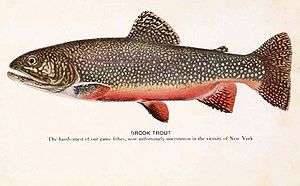stocking density effects on fish | review
Introduction
- growth and performance of some salmonids [1] [2][3]
- decreased food consumption[4]
- social interaction[5][4:1]
- altered water quality[6][7]
- growth-regulating role of hormones in fish held at high stocking density [8][2:1]
- chronic stress; water quality, adverse social interactions or over-crowding, negative physiological and biochemical changes [3:1][9]
- Reducing Lysozyme[10][11]
Salvelinus fontinalis[12]
 |
|---|
| © Wikimedia |
Brook charr
| Fish | Date | Effects | Paper |
|---|---|---|---|
| Salvelinus fontinalis | 1990 | energy metabolism of brook charr | M.M.Vijayan[12:1] |
Brook charr:
- reared for 30 days
| Lower | Higher | No effect |
|---|---|---|
| - final body weight - reduced food consumption - plasma T4 concentration was lowered - Lower Plasma glucose levels - Lower liver glycogen content - Lower hepatosomatic index - Hepatic hexokinase - glucose-6-phosphate dehydrogenase activities |
- fructose biphosphatase - 3-hydroxyacyl CoA dehydrogenase - glycerol kinase - glycerol-3-phosphate dehydrogenase |
- T3 concentrations - plasma protein - free fatty acid (FFA) levels - pyruvate kinase - glucose-6-phosphatase - phosphoenolpyruvate carboxykinase - glutamate dehydrogenase - glutamate pyruvate transaminase - glutamate oxaloacetate transaminase - plasma cortisol |
These results suggest that high stocking density has the effect of mobilizing triglyceride sources, promoting gluconeogenesis from glycerol, but has little effect on protein metabolism.
VE[13]
-
18 weeks
-
diets supplemented with 450 mg of vitamin E showed an increase (P!0.05) in the accumulation of macrophages foreign body giant cells and Langhans type cells.
-
not show a similar difference in plasma cortisol concentrations related to stocking density
Silver perch[14]
 |
|---|
| © goodfish.org |
-
Densities of 12, 25, 50, 100 or 200 fish/m3 in cages (1 m3) in an aerated
-
Cultured for 210 days
-
There was aggression between fish in cages stocked at 25 or 50 fish/m3
-
survival (50% and 64.5%, respectively) was significantly lower (P < 0.01) than at the other densities (87.5%, 98.5% and 97.4%).
-
Stocking density did not affect final weight (454.6–471.1 g), specific growth rate (0.65–0.70%/day) or absolute growth rate (1.6–1.7 g/fish/day)
-
feed conversion ratios (FCR) of fish stocked at 25 or 50 fish/m3 (4.4 and 3.7) were significantly higher (P < 0.01) than FCRs (range, 2.3–2.5) at other densities.
-
Coefficients of variation in weight (CV) at 25 or 50 fish/m3 (24.4% and 28.3%) were significantly higher (P < 0.01) than at other densities and the lowest CV of 16.1% was at 200 fish/m3.
-
Production was significantly affected (P < 0.01) by stocking density, with the highest mean rate of 88.5 kg/m3 in cages stocked with 200 fish/m3.
-
One infestation of the ectoparasitic ciliate, Chilodonella hexasticha, and two infestations of the monogenean gill fluke, Lepidotrema bidyana, were each treated successfully with an application of 30 mg/l formalin. The high survival, relatively fast growth, low variation in weight and high production rates of silver perch stocked at 100 or 200 fish/m3 demonstrate that cages are a viable alternative to ponds for the commercial production of silver perch.
| 12 | 25 | 50 | 100 | 200 | |
|---|---|---|---|---|---|
| Survival(%) | 87.5(7.2)a | 50.0(6.4)b | 64.5(7.6)b | 98.5(1.5)c | 97.4(1.4)c |
| Weight(g) | 455.1(20.5) | 454.6(32.4) | 469.7(12.4) | 471.1(15.7) | 460.2(16.1) |
| CV(%) | 20.1(2.5)a | 24.4(2.8)b | 28.3(3.2)b | 18.9(2.1)a,c | 16.1(0.9)c |
| SGR(%/day) | 0.68(0.02) | 0.65(0.03) | 0.69(0.02) | 0.70(0.03) | 0.68(0.03) |
| AGR(g/day) | 1.6(0.1) | 1.6(0.1) | 1.7(0.1) | 1.7(0.1) | 1.7(0.1) |
| Production(kg/m3) | 4.8(0.4)a | 5.8(1.8)a | 11.9(5.3)b | 46.4(1.8)c | 88.5(2.0)d |
| FCR | 2.5(0.3)a | 4.4(0.3)b | 3.7(0.4)b | 2.3(0.2)a | 2.4(0.2)a |
Survival, final weight, coefficient of variation of weight (CV), specific growth rate (SGR), absolute growth rate (AGR), production and feed conversion ratio (FCR) of silver perch (initial mean weights, 109.3-115.4g) cultured for 210 days at five stocking densities in cages
Feeding Behavior
- Fish in cages stocked at 100 or 200 fish/m3 always fed strongly at and near the surface,
- Feeding behavior in cages stocked at 25 or 50 fish/m3 was intermediate, with fish mostly feeding mid-water, but at times feeding strongly near the surface.
- fish stocked at 12 fish/m3 usually fed mid-water and were rarely seen feeding near the surface throughout the experiment
Aggression Behavior
- observed daily in at 25 or 50 fish/m3,
- eroded fins
- no obvious signs of aggression in cages stocked at 12, 100 or 200 fish/m3
Which interested me
Variation in weight
More related to Stocking density
- Intestinal Microbiota (Pig)[15]
- Intestinal Microbiota (Duck)[16]
- Deposition and transport of trace mineral elements (Pig)[17]
Schreck, C.B., Patino, R., Pring, C.K., Winton, J.R. and Holway, J.E., 1985. Effects of rearing density on indices of smoltification and performance of coho salmon, Oncorhynchus kisutch. Aquaculture, 45: 345-358. ↩︎
Vijayan, M.M. and Leatherland, J.F., 1988. Effect of stocking density on the growth and stressresponse in brook chat-r, Salvelinus fontinalis. Aquaculture, 75: 159-l 70. ↩︎ ↩︎
Bolasina, S., Tagawa, M., Yamashita, Y., Tanaka, M., 2006. Effect of stocking density on growth, digestive enzyme activity and cortisol level in larvae and juveniles of Japanese flounder, Paralichthys olivaceus. Aquaculture 259, 432–443. ↩︎ ↩︎
Refstie, T. and Kittelsen, A., 1976. Effect of density on growth and survival of artificially reared Atlantic salmon. Aquaculture, 8: 3 19-326. ↩︎ ↩︎
Fenderson, O.C. and Carpenter, M.R., 197 1. Effects of crowding on the behaviour of juvenile
hatchery and wild landlocked Atlantic salmon (Satmo saiur L. ). Anim. Behav., 19: 439-447. ↩︎Pickering, A.D. and Stewart, A., 1984. Acclimation of the interrenal tissue of the brown trout, Salmo trutta L., to chronic crowding stress. J. Fish Biol., 24: 131-740. ↩︎
Pickering, A.D. and Pottinger, T.G., 1987a. Poor water quality suppresses the cortisol response of salmonid fish to handling and confinement. J. Fish. Biol., 30: 363-374. ↩︎
Leatherland, J.F. and Cho, C.Y., 1985. Effect of rearing density on thyroid and interrenal gland. activity and plasma and hepatic metabolite levels in rainbow trout, Salmo gairdneri Richardson. J. Fish Biol., 27: 583-592 ↩︎
Montero, D., Izquierdo, M., Tort, L., Robaina, L., Vergara, J., 1999. High stocking density produces crowding stress altering some physiological and biochemical parameters in gilthead seabream, Sparus aurata, juveniles. Fish Physiol. Biochem. 20, 53–60. ↩︎
Costas, B., Aragão, C., Dias, J., Afonso, A., Conceição, L.E., 2013. Interactive effects of a highquality protein diet and high stocking density on the stress response and some innate immune parameters of Senegalese sole Solea senegalensis. Fish Physiol. Biochem. 39, 1141–1151. ↩︎
Liu, Baoliang, et al. “Effects of stocking density on antioxidant status, metabolism and immune response in juvenile turbot (Scophthalmus maximus).” Comparative Biochemistry and Physiology C-toxicology & Pharmacology (2016): 1-8. ↩︎
Vijayan, M. M., J. S. Ballantyne, and J. F. Leatherland. “High stocking density alters the energy metabolism of brook charr, Salvelinus fontinalis.” Aquaculture 88.3-4 (1990): 371-381. ↩︎ ↩︎
Belo, Marco Antonio de Andrade, et al. “Effect of dietary supplementation with vitamin E and stocking density on macrophage recruitment and giant cell formation in the teleost fish, Piaractus mesopotamicus.” Journal of Comparative Pathology 133.2-3 (2005): 146-154. ↩︎
Rowland, Stuart J., et al. “Effects of stocking density on the performance of the Australian freshwater silver perch (Bidyanus bidyanus) in cages.” Aquaculture 253.1-4 (2006): 301-308. ↩︎
Li, Lan, et al. “Intestinal microbiota in growing pigs: effects of stocking density.” Food and Agricultural Immunology 29.1 (2018): 524-535. ↩︎
Wu, Yuqin, et al. “Proteome and microbiota analysis reveals alterations of liver-gut axis under different stocking density of Peking ducks.” PLOS ONE 13.10 (2018). ↩︎
Wu, Xin, et al. “Deposition and transport of trace mineral elements were affected by stocking density in fattening pigs.” Journal of Trace Elements in Medicine and Biology (2018): 566-571. ↩︎
stocking density effects on fish | review
https://karobben.github.io/2020/08/19/LearnNotes/stockingdensity_fish/







